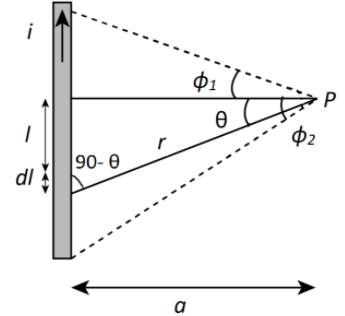Question
Question: A magnetic field due to a long straight wire carrying a current \(I\) is proportional to A. \(I\) ...
A magnetic field due to a long straight wire carrying a current I is proportional to
A. I
B. I2
C. I3
D. I
Solution
Apply Biot- savart’s law by considering an elementary length on the finite straight wire. For the long or infinite length of the straight wire or any conductor, the perpendicular distance from the wire is at the center of the wire that ϕ1=ϕ2=90∘.
Complete step by step solution:
Let us consider an straight wire through which current I flows and a point P, which lies at a perpendicular distance a from the wire as shown in the diagram below:

Now let dl be a small current carrying element at distance r from the point P and the angle between distances r and a be θ. The length between the center of the wire and elementary length is l.
Now we apply Bio- savart’s law, the magnetic field due to the current element dl at point P is,
dB=4πμ0r2Idlsin(90∘−θ) … (I)
From the triangle formed by r,aandl,
r=cosθa … (II)
And
l=atanθ
Now differentiate above equation with respect to θ, we get,
dθdl=asec2θ
⇒dl=asec2θdθ … (III)
Now we substitute the values of dl and r using equation (II) and (III), we have,
dB=4πμ0(cosθa)2I(asec2θdθ)cosθ ⇒dB=4πμ0aIdθcosθ
Now we integrate from −ϕ1 to ϕ2 the above equation,
After further simplifying, we get,
B=4πaμ0I[sinθ]−ϕ1ϕ2 ⇒B=4πaμ0I(sinϕ2+sinϕ1)It is given in the question that the straight wire is long that is infinite, in this the point P always be at the center of the straight wire. So, the angle ϕ1 and ϕ2 will be equal to 90∘.
Now substitute ϕ1 and ϕ2 as 90∘in the above expression.
B=4πaμ0I(sin90∘+sin90∘) ⇒B=4πaμ0I(2) ⇒B=2πaμ0ISince 2πμ0 is a constant quantity, so the above expression can be written as,
B∝aI
Thus, the magnetic field (B) due to a long straight wire carrying a current (I) is proportional to I
So, the correct answer is “Option A”.
Note:
Be careful while answering because the formula for finite straight wire and infinite straight is completely different.
When wire has finite length: B=4πaμ0I(sinϕ2+sinϕ1)
When wire has infinite length, ϕ1=ϕ2=90∘: B=2πaμ0I
When wire has infinite length and point P lies at near wire’s end, ϕ1=90∘andϕ2=0:
B=4πaμ0I
